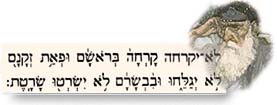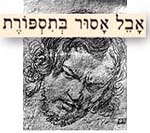|


That
tonsuring, the rite clipping the hair or shaving the head, was
a common rite of mourning in biblical times is evident from the
prophets' descriptions of grief and disaster:
Like gashing the flesh until the blood runs, tearing out or shaving the hair
of one's head were rites of mourning among Israel's neighbors in ancient Canaan.
Despite its prevalence in the region, the Israelite religious establishment
sought to prevent its practice among its own people. "You are children
of the Lord your God. You shall not gash yourselves or shave the front of your
heads because of the dead. For you are a people consecrated to the Lord your
God…."[1]
These practices
were probably understood differently in different cultures. Some
scholars think that they were believed to have an effect on the
ghost of the dead person, either as offerings of blood and hair
to strengthen the ghost in the nether world or to assuage the
ghost's jealousy of the living by showing it how grief-stricken
they are. These rites could also be acts of self-punishment expressing
feelings of guilt, which are often experienced by survivors after
a death. Beating the breast is a mild and permitted way of expressing
such feelings, while gashing and pulling out hair is extreme and,
therefore, forbidden.
Similar laws
against excessive manifestations of grief are found elsewhere.
In Athens, Solon (sixth century BCE) forbade "mourners tearing
themselves to raise pity," and the Twelve Tables of Roman
law (fifth century BCE) forbade mourning women to lacerate their
cheeks.
The words
in Deuteronomy, "For you are a people consecrated to the
Lord your God…."[2]
shed additional light on the prohibition against self-gashing
and shaving one's head: these rites are not compatible with Israel's
status as a people consecrated ("holy") to God. This
reason corresponds to that given in Leviticus[3]
for prohibiting the priests from practicing these rites:
|

"[The
priests] shall not shave smooth any part of their heads,
or cut the side-growth of their beards, or make gashes in
their flesh. They shall be holy to their God and not profane
the name of their God, for they offer the Lord's offerings,
and so must be holy ." (Leviticus 21:5)
|
According
to verses 16-23 in the same chapter, priests who have bodily defects
may not offer the Lord's offerings, lest they profane the sacred
places.[4]
This suggests that self-inflicted bald spots and gashes would
profane those who are holy because they are comparable to bodily
defects. This injunction in Deuteronomy forbidding the entire
people in Israel to engage in these mourning rites recalls the
injunction in Leviticus: "You shall not round off the side-growth
[pe'at rosh'hem] on your head, or destroy the side-growth
[pe-at zekaneha] of your beard. You shall not make gashes
in your flesh for the dead,or incise any marks on yourselves….[5]
The
entire people is consecrated to God and all must maintain a quasi-priestly
level of holiness.

A
mourner may not cut his hair (Moed Katan 14b)
In
time, the custom of shaving one's head as a sign of mourning took
a turn; it became customary for mourners to let their hair grow
during the thirty days of mourning. In Talmudic times all mourners
were enjoined not to shave or cut their hair until the conclusion
of sheloshim (the first thirty days of mourning)[6]
and those who were mourning the death of a parent were urged to
go without shaving or cutting their hair until rebuked by friends
and acquaintances for untidiness.[7]
In a passage aimed at emphasis rather than true legal liability,
this injunction is expressed in the extreme: "A mourner who
does not let his hair grow long and does not rend his clothes
is liable to death," teaches the Talmud.[8]
Many authorities
have commented that it is not necessary to adhere to this rule in places where
being unshaven is considered untidy,[9]
and it has become customary in many circles to resume shaving after the conclusion
of the shiv'ah (seven-day mourning) period.
|
[1]
Deut.
14:1-2 [back]
[2] Deut.
14:2 [back]
[3] Lev. 21:5-6 [back]
[4] Lev. 21:16-23 [back]
[5] Lev. 19:27 [back]
[6]
BT Moed Katan 27b [back]
[7] BT Moed Katan 14a, 22a; Isaac
Klein,
A Guide to Jewish Religious Practice (JTS, 1979) [back]
[8] BT Moed Katan 24a; EJ 10:1484 [back]
[9] Kol Boa'l Aveilut, p. 253; Isaac
Klein, A Guide to Jewish Religious Practice (JTS,
1979)
[back] |
HAIR Table of Contents
|